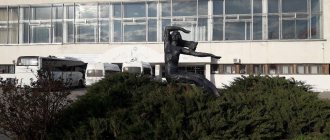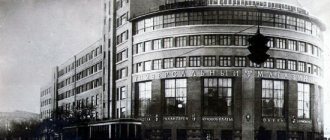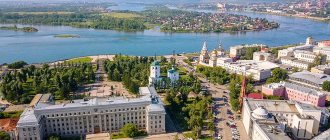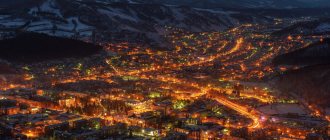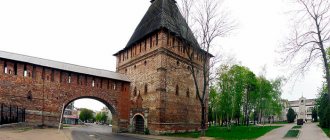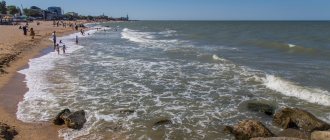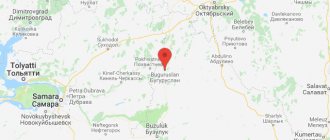What is Kalitva? Surprisingly, toponymists, who seem to know the answers to all questions, did not think about the meaning of this word until the forties. And only M. Makarov, commenting on Mr. Linde’s dictionary, noted: the word probably consists of two “Russianized” derivatives: kolo (about) and Litva.
Indeed, in a city with this name one can still hear words that are clearly of Lithuanian origin. In the south of Russia there is even the city of Belaya Kalitva. The Rostov region, the map of which reflects the diversity of nationalities living here, is proud of this small city, but with a glorious history.
A little history
More than a million people live in the territory called the Rostov region. Belaya Kalitva, which received city status only in 1958, is far from the first place in terms of population. But there are unique monuments here, one of which is known throughout Russia. This is the only monument in the world to the heroes of the Tale of Igor's Campaign. Installed in 1970, it has become one of the pearls of the urban settlement. The entire Rostov region is proud of this monument. Belaya Kalitva is also known for other literary compositions. Sholokhov’s Aksinya and Grandfather Shchukar, the Three Bears from a Russian fairy tale, and other small sculptural forms have long “lived” in the city. Sculptures are one of the main attractions of Belaya Kalitva. The smaller ones decorate lawns and flower beds. The larger ones are installed in gardens and parks. People make dates around them and make marriage proposals. Sculptures are an important part of city life.
However, the Rostov region is known not only for its literary monuments. Belaya Kalitva is also the battle of the Russians with the Polovtsians in 1185, which Boyan sang. This is the history of the Cossacks, directly related to the formation of the city. This is a revolution and a civil war (this is where Voroshilov’s headquarters was located). This is the Great Patriotic War. For six months the city was occupied by the Nazis, but managed to fully recover and heal its wounds. However, the city of Belaya Kalitva in the Rostov region is famous not only for its history.
Kalitva today
The first thing that catches the eye of visitors today is the scaffolding of new buildings. The city is gradually moving deeper into the steppe, turning green spaces into cozy residential areas. Like the entire Rostov region, Belaya Kalitva participates in several housing construction programs. However, the growing modern areas harmonize well with the “old city”.
The residents of Belokalitvina are very fond of their park, founded in the 19th century. Today it bears the name of V. Mayakovsky, and its architecture reflects the entire history of the city. The park has themed corners and attractions, a beach on the banks of the Donets and a modern embankment. With the same love, residents treat Karaul Mountain, which is the highest place in the city, Maidan, on which stands the revived Vvedensky Church, a monument to victims of repression, “Horses” rushing into the steppe (sculpture by S.P. Kalchenko). You can talk about the city for a long time. It is one of the most beautiful places for which the Rostov region is so famous. Belaya Kalitva... It’s worth coming here once and then again and again with pleasure returning to the hospitable city.
The settlement is located on the banks of the Northern Donets River, 168 km from Rostov-on-Don. The total area of the urban settlement is 165 square kilometers.
General data and historical facts
Peter I in 1703 ordered the Cossacks to settle the place on the Belaya Kalitva River. The year of this decree became the date of foundation of the village of Ust-Belocalitvenskaya, which was divided into 4 parts: Nizovka, Zayarovka, Maidan, Bugor.
In September 1937, the village of Ust-Belocalitvenskaya was included in the Rostov region. From July 1942 to January 1943, the settlement was occupied by German troops. During the war, 30 soldiers and lieutenant A. Ataev accomplished a feat. They took the height and held it for more than a day, fighting off enemy forces that were many times superior.
In 1958, the settlement became a city, in 1959 it became a regional center, and in 1988 the Belokalitvinsky district was formed.
In January 2006, the city was transformed into an independent municipal entity. The main enterprise of the city is Alcoa Metallurg Rus CJSC, founded in 1941. This enterprise took part in the development of the Ruslan project aircraft and the Buran spacecraft.
Nowadays, the following products are produced in the city: aluminum products, profiles, hardware, bricks, cornices, reinforced concrete, cardboard, personal protective equipment, flour products, meat.
Religion
Church of the Entry of the Mother of God into the Temple, 1942.
In the city there is the Church of the Entry into the Temple of the Mother of God (Bolshaya St., 2), originally built in the 1780s from wood and rebuilt in stone in 1896-1905. In the 1930s it was closed and the crosses, domes, bell tower and iconostasis were removed. The temple was open for worship during the Great Patriotic War, but in 1961 it will be closed again for the construction of the House of Pioneers. In 1988 it was returned to the Russian Orthodox Church, which began its restoration. [ ][ 19 ]
Another of the local churches is the Church of the Icon of the Sovereign Mother of God (“Sovereign”, Standardstroy Street, 18), built between 2004 and 2007. [ 20 ] [ ]
Attractions
1.Cossack cross
- wooden cross decorated with carvings. At all times, the Don Cossacks worshiped this monument. There is a horse next to the cross. It symbolizes a horse that sometimes returned home without its owner.
2.Red Bridge
- an old bridge that connects the banks of the Seversky Donets River. The building is located at the entrance to the city.
3.Mountains "Two Sisters"
- a beautiful natural attraction, which is located 8 km from the city. Two twin mountains are located on the right bank of the Seversky Donets River.
4.Historical center Maidan
— there are old buildings, commercial facades, and a chapel here. This center is under special control by the city administration.
5.Monument to the “First Teacher”
— the monument is located near one of the oldest schools in the city. The sculpture of a teacher and a first-grader is made of durable concrete with a metallic composition.
Education
In Belaya Kalitva there are seven secondary schools of the municipal budgetary institution of general education - MBOU SOSH, MBOU SOSH-, No. 1, 2, 3, 4, 5, 6 and 17 and one for primary education (No. 1). There are eleven kindergartens in the city (No. 1 “ Topolek
", No. 3
"Little Red Riding Hood"
, No. 6 "
Fairy Tale
", No. 7
Sun
", No. 8 "
Cheburashka
", No. 16
"Golden Fish"
, No. 41 "
Seven-flowered Flower
", No. 42).
Thumbelina
,
nº43 Kolobok
, nº46
Alyonushka
, nº56
Smile
Also in the town is the State School of the Cossack Cadet Corps named after Matvey Platov, to which a women's department was added in 2006 - the Mariinsky Gymnasium. For additional education there is a kindergarten, two children's and youth sports schools and a children's technical school. For vocational education, the Belaya Kalitva State Humanitarian-Industrial College [12] and the Belaya Kalitva Multidisciplinary Technical Institute are located in the city. [ 13 ]
Transport
There is a railway station of the same name in the city. City transport is represented by several bus routes.
Information about the city of Belaya Kalitva, Rostov region
In 1941, the village of Ust-Belokalitvinskaya began to be called the village of Belaya Kalitva, in 1958 the village received the status of a city, and in 1959 - a regional center. Since 1988, the city and the Belokalitvinsky district (76 settlements) have been a single territorial unit with a common “administrative management”. The city and district are located in the central part of the Rostov region, on the eastern tip of the Donetsk Ridge, on the banks of the largest tributary of the Don - the Seversky Donets. The city itself stands at the mouth of the Kalitva and Likhaya rivers flowing into the Donets. There are a total of 6 rivers, 8 rivulets, and 20 streams in the area. The right rocky bank of the Seversky Donets in the vicinity of the city has a highest elevation of 148.8 m above sea level.
The length of the North Caucasian Railway across the territory is 95 km with the stations “Boguraevo”, “Belaya Kalitva”, “Grachi”. The city bus station, located on the Rostov-Volgograd highway, serves 20 intercity routes and 39 transit routes, including those to Ukraine. Summer intercity routes along the Donets have been cancelled, only local ones operate. The local airline airport serves agricultural aviation.
Territory area 2650 sq. km, length from north to south is 150 km. The population as of January 1, 2003 was 113.7 thousand people, of which 82.1 thousand were urban residents, 31.6 were rural residents.
In 1703, a group of Cossacks petitioned military chieftain Ekim Filipyev for permission to settle a new town at the mouth of the Belaya Kalitva River. This date is considered official, although back in 1515, the ambassador of Vasily III Korobov, in his report, mentioned the people he saw at the mouth of the Kalitva. The embassy's route passed along one of the oldest caravan routes through the rifts of the Donets, which shallowed in summer. Excavations in 2002 (Don Archaeological Society, R.V. Prokofiev) indicate that there was an ancient Russian settlement on the territory of the 12-13th century. In 1675 -1683, Old Believers settled in the area, away from the caravan routes.
The entire pre-revolutionary history of Belaya Kalitva is connected with the Cossacks. Among the outstanding military leaders of Belokalitvintsy, Pyotr Ivanovich Pavlov is famous. For the brilliantly organized fortifications in the defense of Sevastopol in 1855, Alexander III personally awarded him the Order of St. Anna 1st degree. During the same war, Colonel Ivan Ivanovich Kostin became famous for his bravery. Major General Viktor Danilovich Popov graduated from service as manager of the Ataman's office. Lieutenant General Nikolai Ivanovich Lazarev distinguished himself in the Russian-Turkish War of 1877 -1878, was awarded gold and silver weapons, and a number of Russian and foreign orders.
Since 1804, stone mining (sandstone, limestone) began in Ust-Belokalitvinskaya; 1827 - coal. The beginning of revolutionary activity in the Ust-Belokalitvinsk mining villages was laid by E.A. Shchadenko and S.S. Turlo.
In May 1918, the headquarters of the 5th and 3rd Ukrainian Red Armies retreating to Tsaritsyn under the command of K.E. was located in Ust-Belokalitvinskaya for several days. Voroshilov. The historic meeting of the Red Army commanders N.A. took place here. Rudneva, A.Ya. Parkhomenko, E.A. Shchadenko and Artem. At the same time, the expedition of F.G. arrived in the village. Podtelkova and M.V. Krivoshlykova.
During the Great Patriotic War, Cossack valor made itself felt: three Belokalitvinians became full holders of the Order of Soldier's Glory, fifteen became Heroes of the Soviet Union. Belaya Kalitva was under occupation for six months. Her liberation took place in the area of the Battle of Stalingrad. In the Belaya Kalitva region there are active Orthodox churches: one from the 18th century (rebuilt) and three from the 19th century. Two churches are being restored and two new ones are being built. On one of the hills located within the city, in 1970, the only monument in Russia to “The Tale of Igor’s Campaign” was erected. There is a municipal historical and local history museum.
The cultural life of the city and region is represented by three music schools and an art school with branches, 44 libraries and 43 club institutions, 195 amateur art groups. Since the work of the famous folklorist, our fellow countryman Professor AM Listopadov (1873-1949), ancient songs have continued to be collected here. A developed sports complex: a Sports Palace with two swimming pools, 98 gyms, two rowing bases, a chess club, four sports schools, including the Olympic reserve.
Four world champions in kayaking and canoeing (1995-2002) and two world champions in athletics (1998, 2003) were raised in Belaya Kalitva. The All-Russian competition named after Hero of the Soviet Union B.I. is held at the rowing base. Bykova. The city-forming enterprise is the metallurgical plant, founded in 1941. In 1969, the plant was the first in the world to master the casting of ingots into an electromagnetic crystallizer (the invention was patented in 17 countries around the world). The specialists became laureates of the USSR State Prize. The plant was the first in the USSR to master the production of Teflon-coated cookware. Participated in projects for the construction of the Ruslan aircraft and the Buran spacecraft, and received the Government Prize No. 11997 in the field of quality.
Belaya Kalitva is a small town in the Rostov region, located on the banks of two rivers, Seversky Donets and Kalitva. Belaya Kalitva can be called one of the monuments of the Cossacks on the Don. ( 78 photos
)
Despite the small number of residents, just over 40 thousand, the city is quite large, relatively speaking, where approximately the same number of people live. Kalitva is located 170 km from Rostov-on-Don.
In a picturesque place, with beautiful nature, on the banks of the Seversky Donets River, which is the largest tributary. By the way, on the same Donets there is a small but beautiful village.
The city was founded in the 18th century as a Cossack village. Then, in 1703, Peter 1 granted the request of the Cossacks to create a farm. But archaeological evidence suggests that the first settlements were formed here already in the 4th century BC. e.
City square, always hungry pigeons do not let children get bored.
The village received city status in 1958, but the entire culture and atmosphere of the Cossack flavor has been preserved to this day. During the Great Patriotic War, the city was captured, and during its liberation, near Belaya Kalitva, the feat of Panfilov’s men was repeated. The Red Army soldiers captured and held the heights.
Lenin Square against the backdrop of the Palace of Culture - Belaya Kalitva photo
The city-forming enterprise is an aluminum smelter, which produces various types of goods, from dishes to load-bearing structures. There are also other types of enterprises, a large number of individual entrepreneurs. In general, it feels like there is money in the city.
There are a large number of monuments in the city. Mainly Cossack themed, many of them are inspired by the years of the Great Patriotic War. Two tanks were installed, one of them at the monument to fallen soldiers with an eternal flame.
Sports are well developed in the city. There is a sports complex (now closed for renovation), a chess club, a rowing base, 4 sports schools, laser tag, paintball, etc.
Belaya Kalitva city photos
Despite the fact that the population in the city is declining, in general Kalitva continues to develop. This is how an entire microdistrict of nine-story buildings was built.
It is worth noting that children in the chess club study for free.
Chess club in Belaya Kalitva
Belaya Kalitva welcomes you with its comfort and unique flavor. Most of the buildings are low; you can hardly find old buildings above 3 floors here. There are many wooden Cossack houses, divided into “bottoms” and “tops”.
The city is rich not only in man-made monuments but also in natural ones. For example, the famous “Two Sisters” mountains. Two completely identical hills are located on the banks of the river, representing a beautiful natural monument.
There are many legends and stories around the mountains. They say that Vanga mentioned them and advised walking barefoot.
Beautiful nature in Belaya Kalitva
People in Kalitva are friendly and kind, easy to communicate with, but educated. You might be surprised when, on public transport, a woman of about 60 years old, with kind eyes, tries to figure out which center you need to go to, while her scream can be heard throughout the entire bus. Out of habit, it may seem that she is angry, but she is not, it’s just a way of communicating, they talk loudly.
And in the vicinity of Kalitva there is an almost abandoned farmstead called Dyadin, it is interesting because famous people, scientists and heroes of the Soviet Union grew up here, but the main thing is that there is a temple here.
There are many stories surrounding the temple. And during the Great Patriotic War, a shell hit it, but practically did not destroy the temple. It has been restored for many years.
Temple in the Dyadin farm
Stunningly beautiful place.
There are several parks in the city, one of them is an amusement park.
Center of Kalitva in the Soviet years.
Kalitva River
In one of the villages of Belaya Kalitva, the traditional annual holiday “Kayal Readings” takes place. At which, in addition to the festive concert, a reconstructed battle between the Russians and the Polovtsians takes place. This battle is sung in “The Tale of Igor’s Campaign.” Historians believe that the battle took place right here, in the interfluve of the Kalitva and Bystraya rivers.
Winter in Kalitva is always spent skating. In several places on the river you can find hockey fields and play with a friendly group.
Another natural monument of Kalitva is a pine forest. Centuries-old pine trees provide an opportunity to take a useful walk before bed and breathe in fresh air filled with the scent of pine.
The city of Belaya Kalitva is located on the territory of the state (country) Russia, which in turn is located on the territory of the continent of Europe.
Economy
View of the city from Zarechny
, a village on the other bank of the Donets.
The main enterprise of the city is the Belokalitvinsky Metallurgical Production Association (BKMPO, built in 1941, since 2005 - a Russian subsidiary of Alcoa). At this plant in 1969, the casting of ingots in an electromagnetic crystallizer was carried out for the first time (patented in 17 countries), for which specialists were nominated for the USSR State Prize. The plant participated in the manufacture of the aircraft
"Ruslan" and the ferry "Buran". Other enterprises in the region produce aluminum alloys and finished products made from them, as well as forging work. The city is home to one of the main coal mines of Donbass. Other factories produce textiles, corrugated cardboard, textile products, sand-lime bricks, road asphalt concrete materials, flour, confectionery and pasta, agricultural machinery, food products (milk, meat, etc.).
Excerpt characterizing Belaya Kalitva
“Thank God,” said the son, smiling. - God has nothing to do with it. Well, tell me,” he continued, returning to his favorite hobby, “how the Germans taught you to fight with Bonaparte according to your new science, called strategy. Prince Andrei smiled. “Let me come to my senses, father,” he said with a smile, showing that his father’s weaknesses did not prevent him from respecting and loving him. - After all, I haven’t settled in yet. “You’re lying, you’re lying,” the old man shouted, shaking his braid to see if it was braided tightly, and grabbing his son’s hand. - The house is ready for your wife. Princess Marya will take her and show her and talk a lot about her. This is their woman's business. I'm glad for her. Sit and tell me. I understand Mikhelson’s army, Tolstoy too... a one-time landing... What will the Southern Army do? Prussia, neutrality... I know that. Austria what? - he said, getting up from his chair and walking around the room with Tikhon running and handing pieces of clothing. - Sweden what? How will Pomerania be transferred? Prince Andrey, seeing the urgency of his father’s demand, at first reluctantly, but then more and more animated and involuntarily, in the middle of the story, out of habit, switching from Russian to French, began to outline the operational plan of the proposed campaign. He told how an army of ninety thousand had to threaten Prussia in order to bring it out of neutrality and draw it into the war, how part of these troops had to unite with the Swedish troops in Stralsund, how two hundred and twenty thousand Austrians, in conjunction with one hundred thousand Russians, had to act in Italy and on the Rhine, and how fifty thousand Russians and fifty thousand Englishmen would land in Naples, and how, as a result, an army of five hundred thousand had to attack the French from different sides. The old prince did not show the slightest interest in the story, as if he was not listening, and, continuing to get dressed as he walked, unexpectedly interrupted him three times. Once he stopped him and shouted: “White!” white! This meant that Tikhon did not give him the vest he wanted. Another time he stopped and asked: “Will she give birth soon?” - and, shaking his head reproachfully, said: - Not good! Keep going, keep going. The third time, when Prince Andrei finished the description, the old man sang in a false and senile voice: “Malbroug s'en va t en guerre. Dieu sait guand reviendra.” [Malbrouk is getting ready to go on a hike. God knows when he will return.] The son just smiled. “I’m not saying that this is a plan that I approve,” said the son, “I just told you what it is.” Napoleon had already drawn up his own plan no worse than this. “Well, you didn’t tell me anything new.” - And the old man thoughtfully said to himself in a patter: - Dieu sait quand reviendra. - Go to the dining room. At the appointed hour, powdered and shaved, the prince went out into the dining room, where his daughter-in-law, Princess Marya, m lle Burien and the prince's architect, who, by a strange whim, was allowed to the table, was waiting for him, although by his position this insignificant person could not count on such an honor . The prince, who firmly adhered to the differences in status in life and rarely allowed even important provincial officials to the table, suddenly proved to the architect Mikhail Ivanovich, who was blowing his nose into a checkered handkerchief in the corner, that all people are equal, and more than once inspired his daughter that Mikhail Ivanovich was nothing worse than you and me. At the table, the prince most often turned to the dumb Mikhail Ivanovich. In the dining room, hugely high, like all the rooms in the house, the household and waiters standing behind each chair were waiting for the prince to leave; the butler, with a napkin on his hand, looked around the table setting, blinking at the footmen and constantly running his restless gaze from the wall clock to the door from which the prince was supposed to appear. Prince Andrei looked at a huge, new to him, golden frame with an image of the family tree of the Bolkonsky princes, hanging opposite an equally huge frame with a poorly made (apparently by the hand of a home painter) image of the sovereign prince in a crown, who was supposed to come from Rurik and be the ancestor Bolkonsky family. Prince Andrei looked at this family tree, shaking his head, and chuckled with the look with which one looks at a portrait that is ridiculously similar. - How do I recognize him all over here! - he said to Princess Marya, who approached him. Princess Marya looked at her brother in surprise. She didn't understand why he was smiling. Everything her father did aroused in her a reverence that was not subject to discussion. “Everyone has their own Achilles’ heel,” continued Prince Andrei. - With his enormous mind, donner dans ce ridicule! [succumb to this pettiness!] Princess Marya could not understand the boldness of her brother’s judgments and was preparing to object to him, when the expected steps were heard from the office: the prince entered quickly, cheerfully, as he always walked, as if deliberately, with his hasty manners, representing the opposite of the strict order of the house . At the same instant, the large clock struck two, and others echoed in a thin voice in the living room. The prince stopped; from under hanging thick eyebrows, lively, brilliant, stern eyes looked at everyone and settled on the young princess. At that time, the young princess experienced the feeling that the courtiers experience at the royal exit, the feeling of fear and respect that this old man aroused in all those close to him. He stroked the princess's head and then, with an awkward movement, patted her on the back of her head. “I’m glad, I’m glad,” he said and, still looking intently into her eyes, quickly walked away and sat down in his place. - Sit down, sit down! Mikhail Ivanovich, sit down. He showed his daughter-in-law a place next to him. The waiter pulled out a chair for her. - Go, go! - said the old man, looking at her rounded waist. – I was in a hurry, it’s not good! He laughed dryly, coldly, unpleasantly, as he always laughed, with only his mouth and not his eyes. “We need to walk, walk, as much as possible, as much as possible,” he said. The little princess did not hear or did not want to hear his words. She was silent and seemed embarrassed. The prince asked her about her father, and the princess spoke and smiled. He asked her about mutual acquaintances: the princess became even more animated and began to talk, conveying her bows and city gossip to the prince. “La comtesse Apraksine, la pauvre, a perdu son Mariei, et elle a pleure les larmes de ses yeux, [Princess Apraksina, poor thing, lost her husband and cried all her eyes out,” she said, becoming more and more animated. As she perked up, the prince looked at her more and more sternly and suddenly, as if having studied her sufficiently and formed a clear concept about her, he turned away from her and turned to Mikhail Ivanovich. - Well, Mikhaila Ivanovich, our Buonaparte is having a bad time. How Prince Andrei (he always called his son that in the third person) told me what forces were gathering against him! And you and I all considered him an empty person. Mikhail Ivanovich, who absolutely did not know when you and I said such words about Bonaparte, but understood that he was needed to enter into a favorite conversation, looked at the young prince in surprise, not knowing what would come of it. – He’s a great tactician! - the prince said to his son, pointing to the architect. And the conversation turned again to the war, about Bonaparte and the current generals and statesmen. The old prince seemed to be convinced not only that all the current leaders were boys who did not understand the ABCs of military and state affairs, and that Bonaparte was an insignificant Frenchman who was successful only because there were no longer Potemkins and Suvorovs to oppose him; but he was even convinced that there were no political difficulties in Europe, there was no war, but there was some kind of puppet comedy that modern people played, pretending to do business. Prince Andrei cheerfully endured his father’s ridicule of new people and with visible joy called his father to a conversation and listened to him. “Everything seems good that was before,” he said, “but didn’t the same Suvorov fall into the trap that Moreau set for him, and didn’t know how to get out of it?” - Who told you this? Who said? - the prince shouted. - Suvorov! - And he threw away the plate, which Tikhon quickly picked up. - Suvorov!... After thinking, Prince Andrei. Two: Friedrich and Suvorov... Moreau! Moreau would have been a prisoner if Suvorov had had his hands free; and in his arms sat Hofs Kriegs Wurst Schnapps Rath. The devil is not happy with him. Come and find out these Hofs Kriegs Wurst Rath! Suvorov didn’t get along with them, so where can Mikhail Kutuzov get along? No, my friend,” he continued, “you and your generals cannot cope with Bonaparte; we need to take the French so that our own people don’t get to know our own and our own people don’t beat our own people. The German Palen was sent to New York, to America, for the Frenchman Moreau,” he said, hinting at the invitation that Moreau made this year to join the Russian service. - Miracles!... Were the Potemkins, Suvorovs, Orlovs Germans? No, brother, either you've all gone crazy, or I've lost my mind. God bless you, and we'll see. Bonaparte became their great commander! Hm!... “I’m not saying anything, so that all the orders are good,” said Prince Andrei, “but I can’t understand how you can judge Bonaparte like that.” Laugh as you want, but Bonaparte is still a great commander! - Mikhaila Ivanovich! - the old prince shouted to the architect, who, busy with the roast, hoped that they had forgotten about him. – Did I tell you that Bonaparte is a great tactician? There he is speaking. “Of course, your Excellency,” answered the architect. The prince laughed again with his cold laugh. – Bonaparte was born in a shirt. His soldiers are wonderful. And he attacked the Germans first. But only lazy people didn’t beat the Germans. Since the world stood still, the Germans have been beaten by everyone. And they are nobody. Only each other. He made his glory on them. And the prince began to analyze all the mistakes that, according to his ideas, Bonaparte made in all his wars and even in state affairs. The son did not object, but it was clear that no matter what arguments were presented to him, he was just as little able to change his mind as the old prince. Prince Andrei listened, refraining from objections and involuntarily wondering how this old man, sitting alone in the village for so many years, could know and discuss in such detail and with such subtlety all the military and political circumstances of Europe in recent years. “Do you think I, an old man, don’t understand the current state of affairs?” – he concluded. - And that’s where it is for me! I don't sleep at night. Well, where is this great commander of yours, where did he show himself? “That would be long,” answered the son. - Go to your Buonaparte. M lle Bourienne, voila encore un admirateur de votre goujat d'empereur! [here is another admirer of your servile emperor...] - he shouted in excellent French. – Vous savez, que je ne suis pas bonapartiste, mon prince. [You know, prince, that I am not a Bonapartist.] – “Dieu sait quand reviendra”... [God knows when he will return!] – the prince sang out of tune, laughed even more out of tune and left the table. The little princess remained silent throughout the argument and the rest of the dinner, looking fearfully first at Princess Marya and then at her father-in-law. When they left the table, she took her sister-in-law by the hand and called her to another room. “Comme c'est un homme d'esprit votre pere,” she said, “c'est a cause de cela peut etre qu'il me fait peur.” [What a smart man your father is. Maybe that’s why I’m afraid of him.] – Ax, he’s so kind! - said the princess. Prince Andrey left the next day in the evening. The old prince, without deviating from his order, went to his room after dinner. The little princess was with her sister-in-law. Prince Andrei, dressed in a traveling frock coat without epaulettes, settled down with his valet in the chambers assigned to him. Having examined the stroller and the packing of the suitcases himself, he ordered them to be packed. In the room there remained only those things that Prince Andrei always took with him: a box, a large silver cellar, two Turkish pistols and a saber, a gift from his father, brought from near Ochakov. Prince Andrei had all these travel accessories in great order: everything was new, clean, in cloth covers, carefully tied with ribbons. In moments of departure and change of life, people who are able to think about their actions usually find themselves in a serious mood of thought. At these moments the past is usually reviewed and plans for the future are made. Prince Andrei's face was very thoughtful and tender. He, with his hands behind him, quickly walked around the room from corner to corner, looking ahead of him, and thoughtfully shaking his head. Whether he was afraid to go to war, or sad to leave his wife - maybe both, but, apparently, not wanting to be seen in this position, hearing footsteps in the hallway, he hastily freed his hands, stopped at the table, as if he was tying the cover of a box, and assumed his usual, calm and impenetrable expression. These were the heavy steps of Princess Marya.
Mayakovsky Park
Confluence of rivers Embankment of the park A landmark of the city has become the reconstructed central park of culture and recreation named after.
V.V. Mayakovsky, located between the rivers, where Kalitva flows into the Donets. A unique park in the floodplain of the Kalitva River. The Mayakovsky Park of Culture and Recreation was founded in the 19th century. This is a beautiful place with a magnificent modern embankment, many skillful sculptures, and themed corners reflecting the history of the city. There is a well-maintained beach next to the park. The plans of city organizations include the creation of a city sandy beach on the banks of the Donets. It's big, beautiful, and full of unexpected discoveries. Our park is good. Mayakovsky in any weather, winter and summer, although there is a difference in these seasons. In addition to the attractions, vacationers have access to a zoo and cozy tables, both in the “Golden Fish” and at the tables by the pool with swans, where the smell of barbecue is already emanating from the barbecue. So, dear friends, there is a place in our city where you can relax with the whole family and bring guests from other places. By the way, the city park named after. Mayakovsky took first place among all parks in the Rostov region in terms of a combination of parameters: equipment, landscaping and other items.
City flowers
Decoration of the city Sculptures and flowers “You have captured my heart forever...”
If there were no flowers in the city, it would be gray and boring. Floral oases in the gray asphalt - a splash of wonderful colors, amazing shapes and lines. Flowers are living beauty!
There is a special attitude towards city flowers. They are cherished, protected, and admired by thousands of people. And only an unkind hand will reach out to pick a flower that is already blooming for you and for everyone. In Belaya Kalitva, flower beds are full of flowers from spring to late autumn. On Theater Square, tulips are the first to wake up, and during the time of mass flowering, you can’t take your eyes off the bright flaming bowls. They are replaced by a pink sea, and it changes shades with each “tide”. Flower seedlings migrate to city flower beds from the greenhouse of the Green World Municipal Unitary Enterprise. Thanks to the efforts of this team, sometimes a miracle happens before our eyes - quite recently, in place of an inactive fountain in the Solnechny microdistrict, a flower bed appeared, which one day was full of cheerful heads of petunias. Residents of many homes decorate their yards with flowers and lovingly care for them. It’s very nice to see original flower beds at private shops, whose owners made sure that people were greeted and greeted by beauty.
Every year on City Day we host flower exhibitions. Belokalitvinsk residents willingly present luxurious bouquets and compositions made from material grown on their plots. An obligatory participant in exhibitions is the city club of amateur flower growers.
our pride
New buildings in the city Entrance to the stadium Palace of Culture School No. 2 When you go out to the outskirts of Belaya Kalitva, the first thing that catches your eye is the forest of new buildings.
High in the sky above them, like giant steel arms, the lacy arrows of tower cranes stretched out. Here, step by step, scrapers and bulldozers move forward, to the east. They are waging a duel with the sands, with the steppe, conquering more and more sites for future new buildings. But none of this existed here before. Builders conquered the steppe. Belaya Kalitva has grown, transformed, and become younger. The White Kalitvinians also became different culturally. Three cinemas have been built for them, and there are up to a dozen libraries. The number of schools and medical institutions is growing every year. The education system of Belaya Kalitva and the region includes 45 preschool institutions and 52 secondary schools, including 12 primary, 13 basic and 27 secondary. There are 13,779 students studying there! There is a cadet corps, a boarding school and a rehabilitation center, 7 additional education institutions, and a private English language school. Five schools received Cossack status.
We have always been seriously involved in local history. Nowadays there are school museums in almost every farm school. The environmental work of schoolchildren is relevant. In honor of the 300th anniversary of Belaya Kalitva, young ecologists carried out certification of 37 springs in the area. For success in environmental education of schoolchildren, the Belokalitva education department has received an award from the regional committee for environmental protection for two years in a row.
Snow-white city In Belaya Kalitva and the Belokalitvinsky district there are 43 club institutions, 3 car clubs, a city museum of local lore, three music schools and an art school, two parks and three recreation areas. Amateur artistic performances are represented by 195 groups, including folklore groups. The first village Cossack choir was created by Miron Ivanovich Balakhnin. His daughter Maria Mironovna Moshkarina took up the baton. Her children's folklore ensemble “Zorenka” is known throughout the region! Since the time of Professor A.M. Listopadov, cultural workers collect ancient Cossack songs, replenishing the golden fund of folk art.
...Belaya Kalitva...Yes, she really is white. No matter which way you look at it, you clearly see a snow-white new city, as if washed by the first spring rains, immersed in the emerald greenery of maples, poplars and vineyards. Two- and three-story houses sparkle with their whiteness. The Palace of Culture rises majestically above the rectangular blocks of residential buildings. And nature has surrounded all this with a blue ribbon of the Seversky Donets and the Kalitva River. And nearby, almost on the very bank of the river, lies the city stadium. All conditions for cultural recreation of workers have been created here. Young people have access to a football field, running tracks, and numerous gymnastic equipment. Is this why many young men and women, having finished work, rush here to watch a football match or simply practice.
external reference
- Wikimedia Commons has a media category for Belaya Kalitva
. - This article is a translation of its Russian Wikipedia counterpart, Belaya Kalitva.
- Information about the area (in Russian)
- Belaya Kalitva Forest (in English)
- Topographic maps (in Russian)
- History of the coat of arms of Belaya Kalitva (in Russian)
- Information portal about the city (in Russian)
- Ust-Kalitvianskaya in the Encyclopedic Dictionary of Brockhaus and Efron. St. Petersburg: 1890 - 1907 (in Russian).
| authoritative control |
|
- Data: Q104658
- Multimedia: Belaya Kalitva
References
- Population of the Russian Federation by municipalities as of January 1, 2022
- ↑ a b
Mijaíl Hétmanets, The Secret of the Kayala River: “The Tale of Igor’s Campaign.” Járkiv: 1989, Maidán, 2013 - Encyclopedia of Russian Cities. Moscow: Great Russian Encyclopedia, 2003. ISBN 5-7107-7399-9
- Our city, Belaya Kalitva (in Russian)
- Gert K. Lubbers: 6th German
Army and the civilian population of Stalingrad.
En: Quarterly Journals of Contemporary History
. Volume 54, I, 2006, pp. 87–123 - AV Venkov, Veshensky uprising. Moscow: Veche, 2012
- Cities and districts of the Rostov region. Rostov del Don: Rostovskoye knízhnoye izdatelstsvo, 1987.
- Russia: Injuries from Chemical Train 17 Explosion (in English)
- Emergency near Rostov: 12 carriages were completely burned, 29 people were injured
- Belaya Kalitva railway station. Archived August 23, 2017, at the Wayback Machine. (in Russian)
- Municipal health care institution Central District Hospital
- ↑ School website. Archived August 23, 2022, at the Wayback Machine. (in Russian)
- Department of Education of the Administration of Belokalitvinsky District / bkobr.ru
- Museum website. Archived November 16, 2022, at the Wayback Machine. (in Russian)
- Historical team statistics (in Russian)
- Epic memorial photo. Archived August 24, 2022 at the Wayback Machine..
- Belaya Kalitva Forest. Archived August 17, 2022, at the Wayback Machine. (in English)
- Church of the Entry of the Mother of God into the Temple (in Russian)
- Church website (in Russian)
- Church website (in Russian)
- Church of the Sovereign Icon of the Mother of God (in Russian)
Mountains - Two Sisters
Two Sisters There are many beautiful places in this world.
We also have places you can’t take your eyes off. Two identical mountains, two sisters, rise above the northern Donets. Like two drops similar to each other. They say that there is such a legend. From unhappy love, two sisters turned into two identical mountains. Here they are, the Ridge Mountains - Two Sisters... A fantastic sight - in the frosty morning haze, growing out of the frost-covered coastal forest, two identical mountains rise with stone ridges glowing in the slanting rays of the sun...
Each of the Two Sisters looks like the famous Crimean Ayu-Dag (Bear Mountain), only in miniature (the Sisters are five times lower). But what gives them a special beauty and unique charm is precisely the fact that there are two of them and they are side by side - and every passer-by involuntarily tries to find at least some difference between them. The Two Sisters Mountains are a natural monument and excursion site of Belaya Kalitva, most visited by tourists. The Belokalitvinsk Federation of Mountaineering and Climbing annually conducts ascents to the Two Sisters, in which anyone can take part.
Avila Mountains
Avila Mountains Avila Mountains are only a small part of the large Donetsk ridge, known in ancient times as the Sarmatian Mountains.
The Avila Mountains are located on the picturesque bank of the Kalitva River. They are quite high and on the river side they break off into a sheer rock wall, reflected in the mirror-like surface of the water. At the very top of the rocks is the Avilova Cave. It is not easy to get to it: along the very edge of the cliff the path winds so narrow that it is not possible to place your foot everywhere. Therefore, you have to climb for a long time, sometimes pressing your whole body against the steep wall so as not to fall... The entrance to the cave from the outside is almost invisible: it is so overgrown with bushes. Inside is a small cave, most likely hewn out with an iron tool. “It was named after the elder Avila, who was taken from the cave during the great flood during the reign of Peter I. Where he went afterwards, history is silent. However, a legend has been preserved that a great crowd of people came out to see him off.
